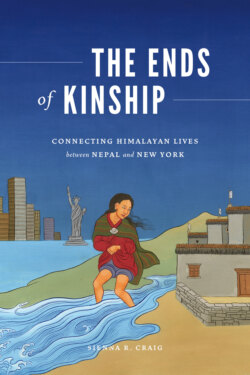Читать книгу The Ends of Kinship - Sienna R. Craig - Страница 19
На сайте Литреса книга снята с продажи.
FAMILY PLANNING
ОглавлениеThe lama and I sit on a grassy knoll beside the village water tap. The cliff out of which his monastery protrudes towers over us. The monk’s shaved head is covered by a rust-colored wool hat, and his robes are tea stained yet neatly folded. He is telling me about the school he runs—a hybrid institution that includes monks, nuns, and a few lay children in one of the hamlets north of Monthang. He has adopted this mode of education because, otherwise, he fears that all the young people will leave the village for boarding schools or monasteries elsewhere. He is worried, among other things, about religious lineage.
The monastery in his charge is a Kagyu institution. “But everywhere these days it is only Sakya,” he says, exasperated. “The parents see that they can get their kids a free education if they send them off to one of the big monasteries in Kathmandu or India, but they don’t think about our own places. They just send them down. And what do we do? We bring in kids from outside. Import-export. Look at Chöde in Monthang or the Tsarang gönpa,” he says. “Do you see Loba kids there? Not many. Most are from Dolpo. They are Gurung or Tamang or the children of laborers who come up to do construction or work in fields. Mustang kids fill up Tibetan monasteries in the south, and our own gönpa become places for outsiders. It should not be this way!”
The lama rolls his prayer beads between his palms and blows on them out of habit, before wrapping them around his wrist. He speaks of the well-educated monks from Mustang, the ones who have gone off to Singapore, Malaysia, and Hong Kong to attend senior Tibetan Buddhist teachers or expound the dharma themselves. “It is good to spread the Buddha’s teachings,” he says, “But for every opportunity, there is an obstacle. For every act of virtue, the possibility of sin. Too often I think these people are ‘om money padme hum.’ They lose their humility and forget the land they come from.” I laugh at his pun. From mani, “prayers,” to “money,” cash.
“The other big problem is the medicine women take. You know, those injections and pills to stop babies from being made. This is sinful. Since women started this practice, we’ve had trouble in the monasteries.”
I swallow and wonder how to respond. “What kind of trouble?” I ask.
“Families used to have five, six children. Older sons would become ngakpa, and middle children went to the monastery or nunnery. But now, people are only having two or three children. This is not enough!”
He tells this story of demographic decline as a morality tale. I think of other stories.
The great expanse of territory that stretches from Mustang and other Himalayan borderlands across the Tibetan Plateau was once envisioned as the supine form of a wrathful demoness. She needed to be subdued—literally staked down to Earth—for Buddhism to thrive. Mustang is marked by the demoness’s dismemberment. Her entrails are reborn as a row of mani stones. That chalky mountainside is her liver. Her heart becomes the 108 chöten that radiate out from Lo Gekhar, one of Mustang’s oldest monasteries, a place associated with Guru Rinpoche and the building of Tibet’s first monastery, Samye.
Much can be said about this story. Buddhism emerges from these acts of gendered violence, even as it is a practice of peace, a way of supplicating and sharpening the mind. I am left considering the need to tether agentive feminine power in order that enduring structures of Tibetan and Himalayan society could be built, could flourish. This says nothing about what it feels like to be pinned to place or to be tethered to one’s body and its wily capacity for making life.
“Sometimes it is difficult for women to have many babies,” I say. “It can be hard on their bodies and their heart-minds.” I remember stories of miscarriages and maternal deaths, secret abortions and efforts to keep contraception hidden from husbands. I think, also, about the Tibetan word for “woman,” kyemen, and its etymological parsing: kye is birth and men indicates something that is lower, below, lesser than.
“I’m a monk!” the lama answers. “What do I know of women’s bodies?”
